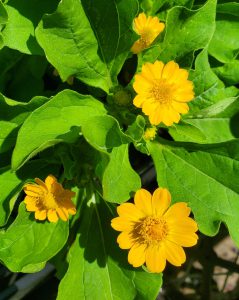
While using common names for plants makes things easy, scientific jargon is more accurate. So, let’s call the nice garden flower in today’s article Melampodium instead of butter daisy. No… I think that butter daisy rolls off the tongue better! I wrote about this wonderful plant a couple of years ago, but I saw it recently at a local nursery and wanted to remind gardeners of this premium summer bedding plant. Butter daisy is a low-maintenance annual flower – favored by pollinators – that will become one your favorites!
Butter daisies are annuals in the Aster Family native to Central America, the Caribbean and Mexico. Expect butter daisies to provide inch-wide yellow, daisy-like flowers with twelve to fifteen petals on light-green foliage. Each flower keeps in good order for several weeks before shattering. Because of this, they do not require deadheading (removal of old flower heads) and keep on blooming uninterrupted. Butter daisies are essentially “self-cleaning” and self-branching making them a low-maintenance delight. Technically this annual could flower until a frost stops them, but the result would be a continuation of flowers long after their expiration date – ugh! Individual aging plants may need to be removed and replaced every four-months or so.
March and April are a good time to install butter daisies into flower beds where mass planting will make the biggest impact. Beyond common butter daisies which can grow up to twenty-four inches tall, shorter cultivars such as ´Derby´ and ´Jackpot Gold´ top off at around twelve inches tall, and compact cultivars such as ´Million Gold´ are only ten-inches in height. Butter daisies are ideal for use as a medium-sized groundcover, a border planting or even as subjects for containers. Plant these daisies in full-sun sites properly spaced ten to fifteen inches apart for good air circulation to ward off powdery mildew, and water to establish. Once established, butter daisies thrive on neglect and nicely tolerate our summer heat and humidity.
Butter daisies, or Melampodium divaricatum, are great annual flowering plants for beginners that are sure to succeed! For more information on all types of flowering annuals suitable for our area, or to ask a question, you can also call the Master Gardener Volunteer Helpdesk on Mondays, Wednesdays and Fridays from 1 to 4 pm at 764-4340 for gardening help and insight into their role as an Extension volunteer. Ralph E. Mitchell is the Director/Horticulture Agent for UF/IFAS Extension – Charlotte County. He can be reached at 941-764-4344 or ralph.mitchell@charlottecountyfl.gov . Connect with us on social media. Like us on Facebook @CharlotteCountyExtension and follow us on Instagram @ifascharco.
Resources:
Brown, S. P. (2021) Gardening with Annuals in Florida. The University of Florida Extension Service, IFAS.
Brown, S. P. (2020) South Florida Gardening Calendar. The University of Florida Extension Service, IFAS.
UF/IFAS Gardening Solutions – Summer Bedding Plants (2018) The University of Florida Extension Service, IFAS.
Christman, S. (2003) Melampodium divaricatum. Floridata.com.
Missouri Botanical Garden – Melampodium divaricatum (2023) https://www.missouribotanicalgarden.org/PlantFinder/PlantFinderDetails.aspx?kempercode=a116 .
Plant of the Week: Melampodium divaricatum; Melampodium, Butter Daisy, Blackfoot Daisy (2023) University of Arkansas Extension Service.
Smith, B. H. (2022) MELAMPODIUM OR BUTTER DAISY. Clemson Cooperative Extension.
 2
2
